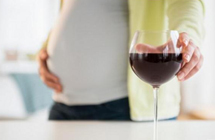研究:孕妇饮酒影响婴儿颜值
|
一项新研究称,怀孕期间只喝几杯酒也会改变胎儿的面部特征。澳大利亚默多克儿童研究所的研究人员分析了415个婴儿的三维颅面图像,以检测孕妇摄入酒精对孩子颅面形态发育的影响。他们发现,妈妈孕期是否饮酒对婴儿面中部、鼻子、嘴唇以及眼睛的形态影响十分明显。孕期喝酒的妈妈,其孩子面中部往往更塌陷,鼻子更上翻。 Just a couple of glasses of wine during pregnancy could alter your child's facial features, a new study claims. It has long been seen that alcohol can infect a fetus, causing developmental delays in the brain. In the more severe cases, those delays can trigger facial defects.
However, a new Australian study published in JAMA Pediatrics has found that small quantities of alcohol could alter a child's face without necessarily causing cognitive issues. Researchers analyzed photographs of 415 babies' faces to detect a series of subtle differences connected to alcohol consumption - such as a slighter shorter, upturned nose. However, they said they do not have any evidence to show these delays in facial development are harmful in any other way than aesthetic. There is no definitive guideline on how much alcohol is safe to consume during pregnancy. The CDC warns that: 'There is no known safe amount of alcohol use during pregnancy or while trying to get pregnant. There is also no safe time during pregnancy to drink. All types of alcohol are equally harmful.' This new study by the Murdoch Children's Research Institute in Victoria, Australia found any alcohol consumption has consequences on craniofacial development. Researchers recruited mothers in the first trimester of pregnancy from low-risk, public maternity clinics in metropolitan Melbourne, Australia, between January 2011 and December 2014. They ended up with 415 white children (195 girls and 220 boys) who had been exposed to a full range of alcohol - from binge drinking throughout pregnancy to low level drinking in the first trimester. Each one was photographed from many different angles when they reached one year old. Analyzing the three-dimensional craniofacial images, the researchers found significant differences in craniofacial shape between children of women who abstained from alcohol during pregnancy and children with varying levels of prenatal alcohol exposure. Stark differences were seen around the midface, nose, lips, and eyes. Alcohol-exposed children tended to have a more sunken midface and a turned-up nose. Those who experienced low exposure in the first trimester tended to only show differences in their forehead size. |









